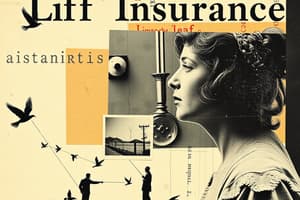Podcast
Questions and Answers
Match the following scenarios with their appropriate outcomes regarding life insurance beneficiaries:
Match the following scenarios with their appropriate outcomes regarding life insurance beneficiaries:
Insured and primary beneficiary die in the same accident = Proceeds directed to insured's contingent beneficiary Policyowner changes a revocable beneficiary = Can be done anytime Lowest cost premium schedule = Annual premium schedule Level premium = Premium is fixed for the duration of the contract Monthly premium payment mode = Gross premium is higher than annual mode Determine conversion of term policy = Cost affects the decision Fatal accident involving insured and beneficiary = Proceeds paid to beneficiary's estate if beneficiary dies first Qualified to change beneficiary designation = Policyowner Contingent beneficiary in AD&D policy = Receives proceeds if primary beneficiary dies before the insured Death benefit distribution after one beneficiary's death = $0 to contingent beneficiary if they die before insured Accidental Death benefits in car accident = Paid to primary beneficiary if contingent is also deceased Frequency of premium payments feature = Premium Mode Guardian required for minor beneficiary = True Consent required for change of beneficiary = Irrevocable beneficiary Underlying concept of level premiums = Early years charged more than needed Primary beneficiary has died before insured = Proceeds to contingent beneficiary Permanent change of beneficiary = Irrevocable designation Pay premiums more than once a year = Mode of Premium Death proceeds directed under Common Disaster clause = To daughter if both parents die Right to change beneficiaries = Revocable designation Type of beneficiary that can be changed anytime = Revocable Policyowner's right to change beneficiary = True Incorrect statement about federal income tax treatment = Entire cash surrender value is taxable Limited rights under beneficiary designation = Irrevocable designation
If the insured and primary beneficiary are both killed in the same accident and it cannot be determined who died first, where are the death proceeds directed?
If the insured and primary beneficiary are both killed in the same accident and it cannot be determined who died first, where are the death proceeds directed?
Insured's contingent beneficiary
When can a policyowner change a revocable beneficiary?
When can a policyowner change a revocable beneficiary?
Anytime
Which premium schedule results in the lowest cost to the policyowner?
Which premium schedule results in the lowest cost to the policyowner?
A level premium indicates what?
A level premium indicates what?
What happens if K and her husband are both killed in an automobile accident regarding death proceeds?
What happens if K and her husband are both killed in an automobile accident regarding death proceeds?
What kind of life insurance beneficiary requires his/her consent when a change of beneficiary is made?
What kind of life insurance beneficiary requires his/her consent when a change of beneficiary is made?
What factor would affect C’s decision on converting her term life policy to whole life insurance the most?
What factor would affect C’s decision on converting her term life policy to whole life insurance the most?
What type of designation should a policyowner use to make a change of beneficiary permanent?
What type of designation should a policyowner use to make a change of beneficiary permanent?
How would a contingent beneficiary receive the policy proceeds in an Accidental Death and Dismemberment (AD&D) policy?
How would a contingent beneficiary receive the policy proceeds in an Accidental Death and Dismemberment (AD&D) policy?
Flashcards are hidden until you start studying
Study Notes
Life Insurance Premiums and Beneficiaries
- Under the Uniform Simultaneous Death Act, if both the insured and the primary beneficiary die in the same accident and the order of death is unknown, proceeds go to the contingent beneficiary.
- A policyowner can change a revocable beneficiary at any time, ensuring flexibility in beneficiary designations.
- The annual premium payment schedule is the most cost-effective option for policyowners, as it typically results in lower overall costs.
- A level premium means the payment amount remains fixed throughout the life of the insurance contract, providing stability in budgeting.
- Opting for a monthly premium payment mode increases the gross premium, making it higher compared to an annual payment.
- In deciding whether to convert a term life policy to whole life, the most significant factor for the policyowner is the associated cost.
- Under the Common Disaster provision, if the insured dies before the beneficiary in a fatal accident, death proceeds will go to the beneficiary’s estate.
- Only the policyowner has the authority to change the beneficiary designation on a life insurance policy.
- A contingent beneficiary will receive policy proceeds in an Accidental Death and Dismemberment (AD&D) policy if the primary beneficiary dies before the insured.
- If named co-primary beneficiaries die simultaneously, contingent beneficiaries will normally not receive any benefits unless specified otherwise.
- Accidental Death benefits will be paid to the primary beneficiary only if the contingent beneficiary dies in circumstances affecting eligibility for the benefit.
- Policyowners can choose their premium payment frequency through a feature called Premium Mode, allowing for personalized budgeting.
- Minors designated as beneficiaries usually require a guardian appointed in the beneficiary clause of the contract to manage the funds.
- An irrevocable beneficiary must consent to any changes made to the beneficiary designation.
- Level premiums often mean that early payments are higher than immediate needs, helping subsidize later lower costs.
- If the primary beneficiary has predeceased the insured, proceeds will go to the contingent beneficiary.
- For a permanent change of the beneficiary on a life policy, the policyowner should opt for an irrevocable designation.
- Policyowners can pay premiums more than once a year under the Mode of Premium provision.
- Under the Common Disaster clause, if both policyholder and beneficiary die together, proceeds would go to the contingent beneficiary.
- To maintain the ability to change beneficiaries, a revocable designation should be selected.
- With the right to change beneficiary, a revocable beneficiary designation allows freedom for adjustments.
- The Change of Beneficiary provision grants the policyowner the authority to modify the beneficiary at their discretion.
- A key misconception about federal income tax treatment of life insurance is that the entire cash surrender value is taxable; this is incorrect.
- Policyowner rights are restricted under an irrevocable designation, limiting changes to the beneficiary without consent.
Studying That Suits You
Use AI to generate personalized quizzes and flashcards to suit your learning preferences.





